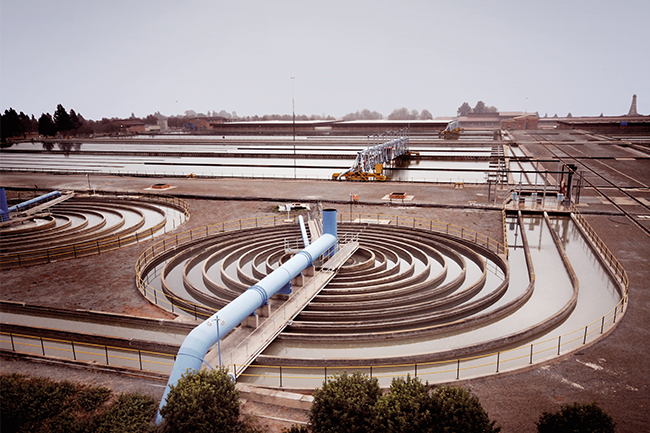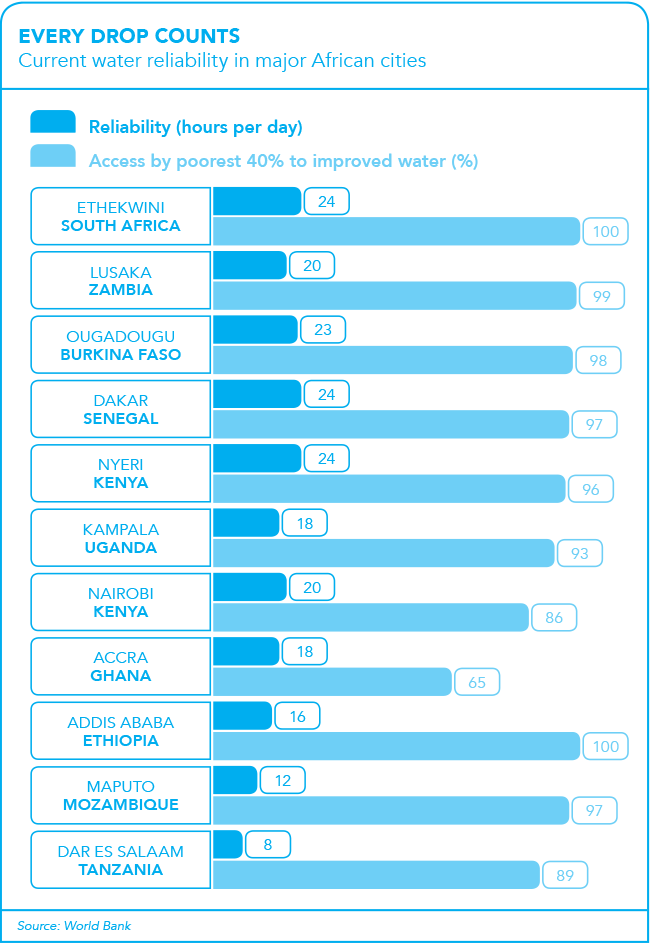According to the World Health Organisation (WHO), some 300 million Africans live in a water-stressed environment, which results in knock-on effects for health, productivity and future prospects. Water scarcity forces people to look to unsafe sources that can lead to the spread of water-borne diseases such as typhoid, cholera and dysentery.
In 2012, the WHO stated that more than 50% of hospital beds in developing countries were occupied by victims suffering from water-borne diseases. A landmark 2008 report by the WHO concluded that a US$11.3 billion investment in water purification, every year, would pay back an annual US$84 billion in improved economic efficiencies. The organisation also argued that health agencies could save US$7 billion every year.
More recent WHO data suggests that on average – in sub-Saharan countries – treatment of diarrhoea due to water contamination absorbs 12% of health budgets. Kenya spends KES27 billion a year on water hygiene-related diseases such as cholera.
Traditionally, there has been a vicious cycle in the water sector in sub-Saharan Africa. Low incomes mean low levels of investment in water infrastructure and management. But poor-quality water supply means health and economic production are compromised which, as a result, tends to keep income levels low. Only in recent years, with the increasing involvement of private-sector water solutions providers, have ways of breaking the cycle become apparent.
What has become clear is that the issue needs to be tackled simultaneously on many fronts, from big bulk supply engineering to micro-level municipal water and waste water purification plants. There are solutions available in Africa but they need to be found and used.
Conventionally, a country is considered water stressed where less than 1 700 m3 is available per person annually. While the sheer shortage of water plays a role, it may be that the continent’s biggest deficiency is less in the quantity of the resource, than in the quality of water management. This is the view of Duncan Hay, executive director of the Institute for Natural Resources (INR).
‘Water, unlike oil and coal, is a resource that we can treat and re-use,’ says Hay. ‘Windhoek has been doing this for 35 years. What we have is not a crisis of water availability – we have a crisis of management.’
Windhoek – the capital of Namibia – is a city with a population of 350 000 people. Since 1969, at least one-third of its water supply has been provided by recycling its own domestic sewage effluent. Filtered through the Goreangab water reclamation plant, the proportion of recovered water varies from year-to-year depending on how good the annual rains have been. The original plant has been supplemented by a second plant, which was completed in 2002.
These two direct potable reclamation plants – in combination with processes to artificially recharge the aquifer under the city during wet years and careful water-demand management – maintain adequate water supply in a city that could not survive on rainfall alone.
Hay argues that efficient water allocation systems are the key to water security. The Umgeni river basin, which supplies the 3.5 million population of eThekwini municipality (previously called Durban) has a catchment yield of 440 million m3 of fresh, clean water in a normal year. This translates into a daily allocation of 200 litres per person – which, Hay points out, is a lot more than the 110 litres available to each person in the German city of Hamburg. However, in 2016, Umgeni Water (the utility that manages eThekwini’s water reserves) was forced to impose a 15% restriction on its supplies.
Developing the logic of the management deficiency argument further, Hay says that ‘even in a drought, the most heavily populated part of KwaZulu-Natal doesn’t need more water. What we need is to better manage what we have’.
Hay’s INR is a leading proponent of the ecosystems services approach, which has profound implications for water purification and provision. Ecosystems services include pollination, soil fertility, as well as insect and erosion control. In implementing environmental flows, water managers seek to maintain a pattern that provides for human use and simultaneously maintains processes needed to support healthy river ecosystems.
The approach views water as part of a system that requires regulation and stabilisation. Factors to be considered include climate, water flow and the movement of nutrients. South Africa’s Working for Water programme, which clears alien vegetation from water catchments, is an example of one application of the approach. By some estimates, this programme – first implemented in 1995 – has the potential to increase South Africa’s water availability by nearly 7%.
In Kenya, a similar programme was launched to reduce sediments in the Tana river, which supplies 95% of the water for Nairobi’s 4 million residents and also accounts for about half of the country’s hydroelectric capacity. The programme involves agricultural terracing and replanting of indigenous flora in the catchment area.
Hay’s views echo that of the WHO’s, which believes large-scale engineering solutions are not always the appropriate answer to water scarcity. The organisation adds that rural areas may require very different interventions to urban areas. It further points to the management issues. The WHO says: ‘While most communities strive for water-borne sewerage systems, these can be sources of disease if they are not managed and maintained effectively.’
However, this is not to disregard the role of infrastructure – both big and small – in water provision. Advocates of an ecosystems service approach do not necessarily disagree. Kate Pringle, principal scientist at the INR suggests that the continent’s solution requires a combination of hard infrastructure and ecosystem service management.
Commenting on the effects of the current drought in South Africa, Peter Townsend, senior engineer at WSP Parsons Brinckerhoff points out that ‘some experts believe that broader patterns, such as weather and yearly rainfall, will be altered’.
Townsend argues that beyond the current drought and El Niño cycle, rainfall and thus water supply will be lower in much of South Africa. ‘To win back any kind of water security, we need to be able to store more water. If a multi-layered approach can be taken to upgrade and raise our existing dams, we would be able to increase the country’s water storage capacity and water supply by approximately 20% to 30%.’
There certainly is plenty of room for more bulk infrastructure in sub-Saharan Africa. Last year the IMF estimated the continent’s average annual ‘water infrastructure investment gap’ to be US$22 billion. The IMF points out that countries such as the DRC and Angola ‘are gifted with some of the most ample water supplies in the world’. Yet they have some of the lowest rates of access to safe drinking water in Africa. In Angola only 54% of the population have potable water while the figure for the DRC is even worse at 46%.
Fortunately, the IMF was able to report that almost all sub-Saharan African countries have infrastructure development strategies in the water sector. The Kenyan government, for example, has plans for 100% supply coverage by 2030. This will require literally hundreds of construction and rehabilitation projects, with the government evidencing particular interest in public-private partnerships.
A sizeable chunk of this effort will be channelled through a parastatal – the Water Service Trust Fund, established in 2004. It has since directed donor funding to 192 projects in rural areas and impacted more than 687 000 people.
The continent’s water management issues come together especially at the municipal level, which is where water purification happens at a plant level. But this part of the system can be easily overwhelmed by pressures related to urbanisation in particular.
According to James Dabrowski, CSIR senior researcher specialising in water quality and aquatic ecology in South Africa, ‘about half the country’s waste water treatment works were in a poor-to-critical state due to infrastructure, capacity, and governance issues’. He added, in a nutshell, that ‘the treatment plants could not handle the volume of effluent’.
This is an area where innovation can make a big impact. One possible solution is that offered by waste water treatment company NuWater. The approach revolves around a patented modular reverse osmosis water treatment unit, which is both mobile and can be used as a temporary fix. The basic unit deals with a water flow of up to 6 million litres per day but can be scaled up in increments as further units are added.
The flexibility of NuWater’s technology means that it can be deployed during rehabilitation of permanent infrastructure. A modular and mobile ‘unit’, as the company calls it, can be hooked up when existing infrastructure is shut down for maintenance or rehabilitation. It can also provide a permanent solution, preferably on a build, own and operate basis.
NuWater has recently started to operate in South Africa’s municipal sphere. In 2015 it took the company just 12 weeks to install its first public sector facility – a 20 million litre treatment plant – in eMalahleni municipality (Witbank).
Africa’s water stresses will not go away any time soon. In fact, the IMF suggests that at the current continental population growth rate of 2.5% – combined with urbanisation – ‘will increase stress on existing infrastructure’.
New dams and purification works are in the pipeline all over the continent. But it is the management of the resource that will make or break the current drive for growth. There is considerable experience within Africa, much of it contained in the private sector. This is a resource that should be tapped.




